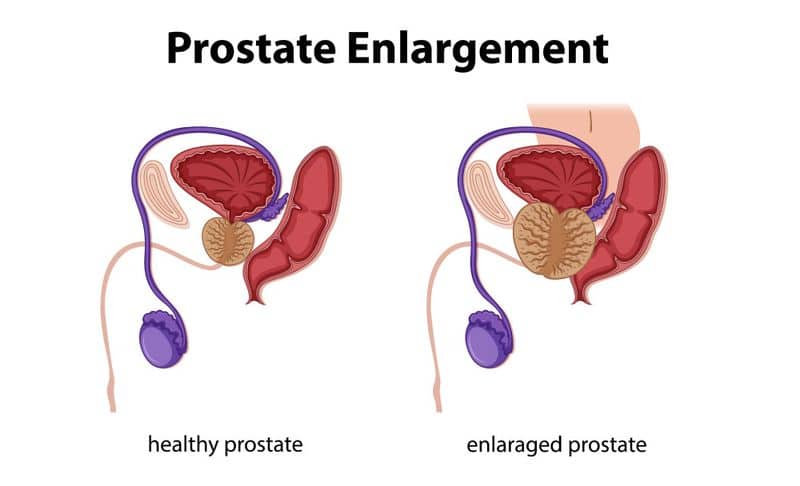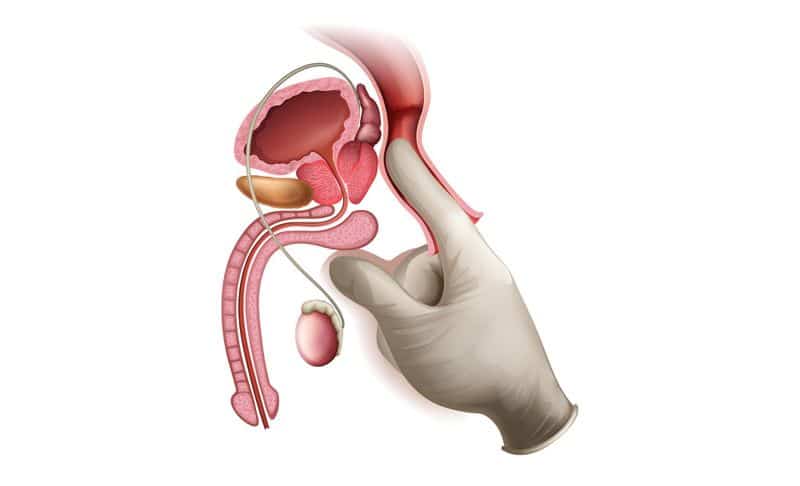
Have you heard of enlarged prostate problems? It is a very common issue among aged males. The prostate gland is a walnut-shaped gland located below the bladder and in front of the rectum in males.
The prostate gland produces fluid that nourishes and transports sperm. Prostatomegaly, also known as an enlarged prostate or Benign Prostatic Hyperplasia (BPH) – is a common condition that occurs as men age. [1] In other words, prostatomegaly means an enlarged prostate gland in males.
In this article, we will discuss the Prostatomegaly symptoms, stages, causes, diagnosis, and prostatomegaly treatment.
What are the Symptoms of Prostatomegaly
“Since prostate enlargement happens gradually, men often think more frequent trips to the bathroom are a natural part of aging.”
-Dr. Howard LeWine (Chief editor at Harvard Health Publishing & assistant professor of medicine at Harvard-affiliated Brigham and Women’s Hospital)
The symptoms vary depending on the severity of the condition. Some men with an enlarged prostate may experience no symptoms at all. However, as the prostate gland continues to grow, it can put pressure on the urethra, the tube that carries urine from the bladder out of the body, leading to the following symptoms:
1. Frequent Urination
Men with prostatomegaly may experience the urge to urinate more often than usual, particularly at night. [1], [2]
2. Difficulty Urinating
An enlarged prostate can make it difficult for urine to flow out of the bladder, resulting in a weak or slow stream of urine, a stream that stops and starts, or the need to strain to urinate. [1], [2]
3. Incomplete Emptying of the Bladder
Men with prostatomegaly may feel like they need to urinate again soon after going to the bathroom because their bladder is not completely empty. [1], [2]
4. Urinary Incontinence
An enlarged prostate can cause urinary incontinence, which is the involuntary leakage of urine. [1], [2]
5. Blood in Urine
In rare cases, an enlarged prostate can cause blood to appear in the urine. [1], [2]
What are the different stages of Prostatomegaly
It can be classified into four stages based on the size of the prostate gland, as determined by a digital rectal exam or imaging tests like an ultrasound or MRI:
1. Stage I: The prostate gland is slightly enlarged, and there are no symptoms. [3]
2. Stage II: The prostate gland is moderately enlarged, and the patient may experience symptoms like difficulty urinating or a weak urine stream. [3]
3. Stage III: The prostate gland is significantly enlarged, and the patient experiences severe symptoms like frequent urination, inability to empty the bladder, and urinary incontinence. [3]
4. Stage IV: The prostate gland is extremely enlarged, and the patient experiences the most severe symptoms, like blood in the urine, bladder stones, or kidney damage. [3]
What are the Causes of Prostatomegaly
The exact cause of prostatomegaly is not fully understood. However, research suggests that changes in hormone levels as men age may play a role in the development of an enlarged prostate.
Specifically, an increase in the hormone dihydrotestosterone (DHT) may cause prostate cells to multiply, leading to an enlarged prostate. [2], [3] Other factors that may contribute include:
1. Age: It is more common in men over the age of 50. [2], [3]
2. Family History: Men with a family history of prostate problems are more likely to develop an enlarged prostate. [2], [3]
3. Lifestyle Factors: Smoking, obesity, alcoholism, and a diet high in red meat and dairy products may increase the risk of developing prostatomegaly. [2], [3]
How is Prostatomegaly Diagnosed

To diagnose prostatomegaly, a doctor will perform a physical exam, including a digital rectal exam, to check the size and shape of the prostate gland. The doctor may also order blood tests to check for prostate-specific antigen (PSA) levels, a protein produced by the prostate gland that can be elevated in men with prostate problems. [4]
Additional tests may include:
1. Urine Flow Study: This test measures the rate of urine flow and how completely the bladder empties. [4]
2. Ultrasound: An ultrasound uses high-frequency sound waves to produce images of the prostate gland. [4]
3. Cystoscopy: This procedure involves inserting a small, flexible tube with a camera into the urethra to examine the bladder and prostate gland. [4]
4. Biopsy: A biopsy involves taking a small sample of prostate tissue to test for cancer or other conditions. [4]
How to Treat Prostatomegaly
Prostatomegaly treatment depends on the severity of symptoms, the size of the prostate gland, and the patient’s overall health. Treatment options may include:
1. Watchful Waiting
In cases where the symptoms are mild, doctors may recommend a “watchful waiting” approach, which involves monitoring the patient’s condition and symptoms over time. In many cases, patients may recover without needing any active medical treatment. [3],[5]
2. Medications
Some medications, such as alpha-blockers and 5-alpha-reductase inhibitors, may cause the prostate gland to shrink or relax the muscles in the prostate and bladder neck, improving urine flow. [3], [5]
3. Minimally Invasive Procedures
Procedures like transurethral microwave thermotherapy (TUMT) or transurethral needle ablation (TUNA) use heat or radio waves to destroy or remove excess prostate tissue. [3], [5]
4. Surgery
In more severe cases, surgery may be necessary to remove the prostate gland or part of it. Common surgical procedures include transurethral resection of the prostate (TURP) or laser prostatectomy. [3], [5]
Ayurvedic Approach to Prostatomegaly
Ayurveda identifies two conditions, called Mootrakruchra and Mootraaghaata, which exhibit symptoms of Prostatomegaly. Mootrakruchra, or strangury, is characterized by excruciating pain during urination, whereas in Mootraaghaata, there is either a complete blockage or intermittent flow of urine during urination. [6]
In India, natural therapies have a long-standing history of promoting optimal prostate health. Gokshura (also known as Gokhru), scientifically named Tribulus Terrestris, has been traditionally used to treat urogenital conditions.

To prepare it, grind two teaspoons of the fruit coarsely and boil it in two cups of water until half of the water remains. Drink one cup of this preparation, optionally, with sugar and milk. Gokshura can also be boiled in milk. [6]
Two other botanicals, Varuna (Crataeva religiosa) and Punarnava (Boerhaavia diffusa), have also been shown to alleviate symptoms of Prostatomegaly. Clinical trials have demonstrated that both of these botanicals possess significant anti-inflammatory properties, particularly with regard to the genitourinary tract. [6]
Ayurvedic Prostatomegaly treatment can work in conjunction with conventional treatments to ease the symptoms of Prostatomegaly but cannot be used as a substitute for treating the condition. It is important to get a prostate examination regularly after the age of 55, follow the advice of your medical practitioner, and get the necessary treatment.
How to Prevent Prostatomegaly
While there is no surefire way to prevent prostatomegaly, there are some lifestyle changes men can make to reduce their risk of developing the condition. These include:
1. Eating a Healthy Diet
A diet that is high in fruits, vegetables, and whole grains and low in red meat and dairy products may reduce the risk of developing an enlarged prostate. [7] When it comes to consuming a prostate gland-friendly diet, you must also know what all foods need to be kept out of that diet plan.
Learn – How you can create a healthy and balanced diet
So, the foods to avoid if you have an enlarged prostate include food items like red meat, sugary foods, dairy food products, high-fat foods, processed foods, high-sodium foods, and deep-fried foods.
2. Exercising Regularly
Regular exercises, such as brisk walking, swimming, or cycling, can help maintain a healthy weight and reduce the risk of developing prostatomegaly. [7]
3. Quitting Smoking
Smoking has been linked to an increased risk of developing prostate problems, including prostatomegaly. [7]
4. Practising Good Hygiene
Good hygiene, including regular hand washing and avoiding contact with people who are sick, can help prevent urinary tract infections that can lead to prostatomegaly. [7]
Did you know?
There are some highly effective Yoga postures for improving prostate health. Yogasanas like Dhanurasana, Virasana, Janu Sirsasana, Baddha Konasana, and Supta Padangusthasana.
FAQs
1. Is prostatomegaly the same as prostate cancer?
No, prostatomegaly is not the same as prostate cancer. Prostatomegaly is a non-cancerous enlargement of the prostate gland, while prostate cancer is a malignant tumor that develops in the prostate gland. However, having prostatomegaly may increase the risk of developing prostate cancer.
2. How common is prostatomegaly?
Prostatomegaly is a very common condition, especially in men over the age of 50. It is estimated that up to 90% of men over the age of 80 may have some degree of prostatomegaly.
3. Are there any complications associated with prostatomegaly?
In some cases, prostatomegaly can lead to complications such as urinary tract infections, bladder stones, urinary retention, and kidney damage. It is important to seek medical attention if you are experiencing symptoms of prostatomegaly to prevent these complications from occurring.
4. How long does it take for prostatomegaly to develop?
The development of prostatomegaly varies from person to person and can take several years. However, it is more common in older men, and the risk of developing the condition increases with age.
5. Can prostatomegaly recur after treatment?
Yes, prostatomegaly can recur after treatment. Regular follow-up appointments with your doctor may be necessary to monitor your condition and adjust treatment as needed.
Conclusion
Prostatomegaly is a common condition that affects many men as they age. While the exact cause of the condition is not fully understood, changes in hormone levels and other factors like age, family history, and lifestyle factors may contribute to the development of an enlarged prostate.
If you are experiencing symptoms of prostatomegaly, it is important to see a doctor for an accurate diagnosis and appropriate treatment. By making certain lifestyle changes, such as eating a healthy diet, exercising regularly, quitting smoking, and practicing good hygiene, men may be able to reduce their risk of developing an enlarged prostate and other prostate problems.
Disclaimer:
This article is from an informational and modern medicine perspective only and does not constitute medical advice. Kindly seek the help of a trained medical practitioner before initiating any treatment.
References:
- Prostate Enlargement (Benign Prostatic Hyperplasia) – NIDDK (nih.gov)
- Benign Prostatic Hyperplasia (BPH): Symptoms, Diagnosis & Treatment – Urology Care Foundation (urologyhealth.org)
- Diagnosis and treatment of benign prostate hyperplasia in Asia – PMC (nih.gov)
- Enlarged Prostate (BPH) – Diagnosis and Treatment (radiologyinfo.org)
- Current Treatment for Benign Prostatic Hyperplasia – PMC (nih.gov)
- Various treatment options for benign prostatic hyperplasia: A current update – PMC (nih.gov)
- Prevention of Benign Prostatic Hyperplasia Disease – ScienceDirect

















